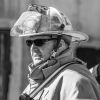Firefighter training is conducted a lot of different ways, depending on where you serve and who’s coordinating your training. It can also vary widely depending on whether you are participating in company-level training, multi-company training, or attending a local, regional, state or national conference. Training is vital for preparing everyone in the fire service to safely perform our jobs in the service of our communities.
For many of us, firefighter training drills are an opportunity to focus on a specific skill or tasks. Whether learning something new or focusing on skills proficiency, task-based training is vital to preparing us to carry out tasks correctly and efficiently when it matters most. Generally, training is conducted with tools and equipment pre-staged at a location, which allows crews to efficiently perform a skill and then quickly reset for the next participants to begin. The value in this type of training is it allows many participants to rotate through training evolutions quickly and have several opportunities to practice in a short time frame.
As an instructor, training manager and fellow firefighter, I see the benefits of focused, task-oriented training. But, if we must “train like we fight,” then I believe we may be missing an important aspect of our job. What I am talking about is the “big picture” of the full response cycle.
As some of you read this, you may think I am referencing NFPA 1410: Standard on Training for Emergency Scene Operations, but I am not. This standard is important for crew deployment and outlines a series of proficiency standards that crews are expected to perform within time constraints. What I am talking about is developing and performing a firefighter training drill that includes all phases of the response, from dispatch to completion. This type of drill is not common for many departments and is useful for identifying shortfalls in crew readiness and performance, especially on fundamental basic skills.
I have a unique opportunity to travel around the country to conduct and observe training sessions. Many times, I watch as firefighters are asked to perform a few tasks at a time—starting a saw, setting up a pump at the fire ground, etc. In this training environment, participants complete these tasks with a high degree of proficiency and accuracy. But keep in mind, these are specific tasks, being performed in a controlled environment, under known conditions.
I also have had the opportunity to watch firefighters participate in training drills where they must perform the entire response cycle—dispatch of the “call,” turnout and response, arrival at the incident scene (training ground) and performance of several fire ground tasks before the evolution is complete. Many times, these drills are conducted using mobile props, at locations other than the organization’s usual training center. This introduces the element of unfamiliar conditions.
I recognize that trying to include the entire response sequence in every training session simply isn’t possible or practical—and it doesn’t need to be. But if you conduct this type of training occasionally, you might be surprised at how you, your crew and your department will perform. Many fire service organizations believe their crews are at a high state of readiness. But that assessment of readiness is generally based on individual skills assessments and not the entire response sequence. As a result, the department may have a false sense of readiness because the test didn’t represent realistic conditions and circumstances. Basically, we didn’t ask them to respond during training, so we don’t really know how they will respond during the real thing.
The closest most of us get to this kind of training is community readiness training, such as active-shooter or violent-encounter drills, multi-company training, or a drill involving a tornado, earthquake or other natural disaster scenario. Many times, the after-action review includes comments about failures in communications, crew coordination and other similar areas identified for improvement. If we recognize the need to train in this manner for a large-scale event, why don’t we do it for a more common high-risk/low frequency event—response to a structure fire?
If you conduct these kinds of firefighter training drills, you will likely find basic skills performed incorrectly or completely missed. Common examples include:
- Improper PPE wear (hoods worn improperly, exposed skin, closures not fully closed, extrication gloves worn to live-fire training)
- Waste straps of the SCBA not fastened
- Ladders deployed for rescue when the personnel were assigned to vertical ventilation
These errors may seem small, but they can result in preventable injuries and limit the crew’s ability to complete vital tasks on the fire ground.
Performing a few tasks at once is easy. However, as the complexity and number of tasks increase, the opportunity for failure increases too. If your agency isn’t conducting this kind of training, maybe it’s time to start. Ask your crews to “respond” to their next drill. Even during a non-emergency response, you might be surprised to see personnel fail to follow standard operating procedures and guidelines, exhibit carelessness toward necessary safety measures and demonstrate lack of familiarity with equipment. While these “little things” are usually easily overcome on the training ground, they can create big heartaches at a real incident.
”Full response” drills are difficult to organize and require a commitment to complete, but the benefits make it worth trying to incorporate this type of training into your regimen. Training on the entire response sequence not only identifies the little errors that can have big consequences on the emergency scene, it also more closely mimics real-world conditions, where many actions need to be performed at once, personnel must coordinate their efforts with others, and things don’t always go according to the training checklist. Best of all, conducting a full response drill is a good reminder that none of us are perfect in the fire service—so it can serve as a powerful reminder of the importance of training.













